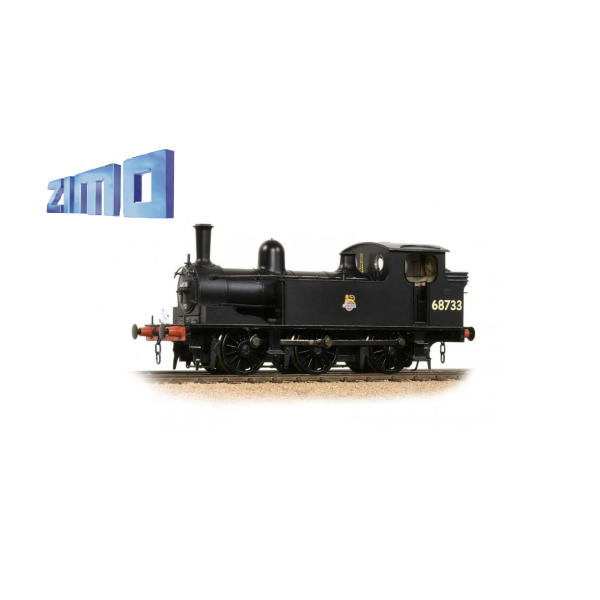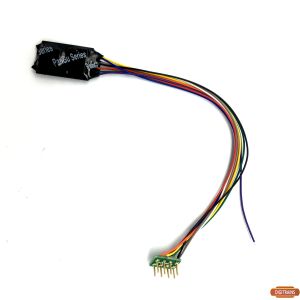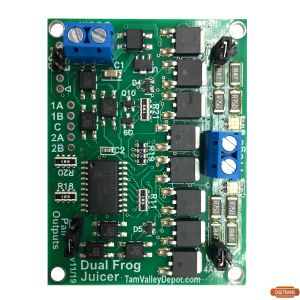CLASS J72 STEAM SOUNDFILE ZIMO
ZS042A Activedrive-Pro J72 steam loco sound project
Please spend a few moments to read these notes which have been produced so that you may obtain the maximum satisfaction from your new sound scheme.
The sounds should work perfectly when the decoder is fitted correctly. Individual locos may require some fine tuning that you can achieve with your DCC controller.
What is ActiveDrive-Pro
This is a system developed to allow you, the user, to change the way that the sounds respond to your driving style or needs. This avoids the need for reprogramming and all the additional costs that would imply.
Operating Your ZIMO Sound Decoder.
As supplied, your new decoder will work in a ‘heavy train’ configuration, but you will be able to switch between the available sounds using your DCC controller by following the straightforward instructions below.
This project utilises Zimo’s ability to switch between the sounds of a heavy train load or sounds of a light engine.
These are all fully configured within the project, waiting for you to make your choice.
You can revert at any time.
All the CVs have been optimised but you may need to make minor adjustments to perfect it for your individual tastes.
There are many Functions, most of which have an individual sound attached. Some will perform a physical function (like turning on the lamps, if fitted), and some will do both (depending on equipment installed). Please study the list below.
Some of the sounds have a finite length and will play from start to finish when selected. Other sounds will ‘loop’ until switched off, whilst others will vary in length, depending on how you operate the F keys on your DCC controller. I’ll leave you with the pleasure of finding out which is which.
In any of the driving sound sets, increasing the speed step by 1 or more will produce an acceleration sound for a few seconds. If you wish continuous acceleration, ease the throttle setting upwards rather than 0- 128 in one jump!
Similarly, in each sound set, a reduction of 1 speed step or more will stop the exhaust beats and the loco will ‘coast’ (or drift) for a few seconds before resuming exhaust beats. Continuous drifting can be simulated by easing the throttle settings down, one step at a time.
All sounds may be modified (including changing or removing them) individually, and the volume levels of each one may also be varied to your own needs. For this, and much more information on your decoder’s outstanding abilities, please download the latest Decoder Manual from http://www.zimo.at/web2010/documents/MX-KleineDecoder_E.pdf
The Sound Sets
There are two sound sets loaded on your decoder.
Set 1 Heavy Loaded. This is the one to use if you have a heavy train on the hook.
Set 2 Light Engine. At very slow speeds, this set will simulate a very lightly stressed loco. This becomes more aggressive with acceleration, and as speed increases. Inertia and momentum settings reduced.
Special Zimo Function on F5.
As supplied, it is possible to toggle between Set 1 and Set 2 (change from one to the other and back again) and this may be done even whilst the loco is moving, with no loss of sound. This is useful to vary the sound of the exhaust beats. But it really comes into its own when you run light loco up to a train, couple up and chug away with the heavy sounds.
All you need to do to make this happen is to press F5 on your DCC controller, and press again to change back.
Heavy Mode default setting
This is the default setting. Inertia and momentum have high settings to reflect the high mass of a loaded train. Maximum power would be required on a real loco to lift a heavy train. This means that as well as opening the regulator, the driver would allow maximum steam into the cylinders with the reverser fully open.
During acceleration, the exhaust beats will bark aggressively, but the tone and volume will soften after a few seconds as the real driver would advance the steam cut-off to reduce steam entering the cylinders, increasing the efficiency of the engine.
Light Engine Mode
Engaging F key 5 will switch the exhaust sounds to a different set of samples, so the ‘chuffing’ is less aggressive in nature and quieter. This represents the reduced ‘cut-off’ on the reverser on real locos.The Inertia and Momentum settings are automatically reduced when Light Engine Mode is selected. The physical characteristics are changed so the model responds more urgently to control inputs. Acceleration is more brisk and stopping distance is reduced.
Dynamic Inertia
In either Heavy or Light modes, flipping the throttle quickly to high speed steps will cause the model to accelerate 3 times more quickly from standing than if the throttle is gradually opened. This is automatic, no F keys are involved.
So now, the rate of acceleration is determined by how wide you open the regulator, just as it would on a real locomotive.
Brakes
F2 will give the sound of brake applications. F2 can be ‘dabbed’ or held for varying durations. The sound will respond accordingly. This also actually slows the loco if you reduce the throttle settings and use the brake.
Heavy load wagons clatter F13
This is the sound of wagons or carriages couplings taking up slack and snatching when you accelerate or slow down. The response is variable upon how roughly you drive. Does not play in light engine mode of course. Switched on with F13.
Variable flange / wheel noise
Selected by F9 this will select flange and wheel noise but it is speed related and changes as you drive. It doesn’t play when stationary or at higher speeds. Low to mid range is where you’ll hear this feature.
Reactive steam blow off / cylinders blow out
On F15 this is the sound of the driver clearing the cylinders before and during setting off, this plays constantly when stationary but pulses with the chuffs as the loco moves off.
Live Volume Control
Provide the sound is switched on and the ‘fade’ button is not active, it is possible to change the overall volume to suit changing needs.
Engage F27 and the sound levels will gradually reduce, eventually to silence.
Engage F28 and the sound levels will gradually increase, eventually to maximum.
In each case, disengage the F key when the desired level is attained. Set F27 and F28 as ‘momentary’ if your DCC controller allows you to do so.
Note: If the volume controls appear to not function, check that F19, F27 and F28 are disengaged before making a further attempt.
Rod Clank Volume
This version has heavy rod clanking included. You can change the volume of these sounds to suit your requirements.
CV286 Higher values will increase volume, lower values will reduce volume relative to the other sounds.
Speed lock
F10 locks the loco speed but allows the throttle to alter the intensity off the chuff from maximum attack down to coasting to simulate a driver keeping his train moving over different track conditions.
Function Keys List
There are 26 Function Keys used in this sound project. Please see below.
Some of the sounds have a finite length and will play from start to finish when selected. Other sounds will ‘loop’ until switched off, whilst others will vary in length, depending on how you operate the F keys on your DCC controller. Some keys have a control function rather than a sound.
Function keys list
F0 Firebox light on it’s own Aux 1&2
F1 Sound on, heavy mode
F2 Brake key, see text
F3 Whistle
F4 Whistle
F5 Light engine mode, see text
F6 Coal shovelling with firebox Aux 1&2
F7 Injector
F8 Blower
F9 Speed dependant flange and wheel noise, see text
F10 Safety valve
F11 Handbrake
F12 Water filling
F13 Wagons clattering, see text
F14 Sanding
F15 Cylinder blow out, see text
F16 Buffer clash
F17 Coupling noise
F18 Guard's whistle
F19 Fade sounds
F27 Volume down
F28 Volume up
CV chart.
|
CV
|
Designation
|
Range
|
Default
|
Description
|
|
1
|
Short Address
|
1 - 127
|
3
|
Active when Bit 5 in CV29 = 0
|
|
2
|
Start Volts
|
1 - 255
|
1
|
Value at speed step 1. Only applies if Bit 4 of CV29 = 0 otherwise the individual speed table is active.
|
|
3
|
Acceleration
|
0 - 255
|
30
|
Multiplied by 0.9 equals time in seconds from stop to full speed.
Influenced by sound project.
|
|
4
|
Braking
|
0 - 255
|
100
|
Multiplied by 0.9 equals time in seconds from full speed to stop.
Influenced by sound project.
|
|
5
|
Top Volts
|
0 - 255
|
1
|
Level applied to the highest speed step in use. Value 0 and 1 = max. Bit 4 in CV # 29 has to be 0 or the individual speed table is active.
|
|
6
|
Mid Volts
|
1
A useful value for CV 6 is ¼ to ½ of the value in CV5
|
1
Default = about 1/3 of top speed
|
Entered value = internal speed step assigned to the cab’s centre speed step (=step 7,14 or 63 according to the number of speed steps selected: 14, 28 or 128)
Bit 4 in CV # 29 has to be 0 or the individual speed table is active
|
|
8
|
Manufacturer ID
and factory reset
|
Read Only
|
145
= ZIMO
|
Setting CV 8 to a value of 8 or 0 will return all CVs to the manufacturer’s default settings. Address = 3
|
|
17 & 18
|
Long Address
|
0001-9999
|
0
|
The long 5-digit primary address (greater than 127). This address is only active when Bit 5 in CV 29 is on. Otherwise the address entered in CV 1 is active (127 or lower).
|
|
29
|
Basic Configuration
CV #29 is calculated by adding the value of the individual bits that are to be “ON”:
Values added together to turn Bits “ON”:
Bit 0: 1
Bit 1: 2
Bit 2: 4
Bit 3: 8
Bit 4: 16
Bit 5: 32
Bit 6: not used
Bit 7: not used
|
0 - 128
|
6
This means that bits 1,2 and 3 are turned on. The loco runs on 28/128 speed steps, DC enabled
|
Bit 0 - Train direction:
off = normal, on = reversed
Bit 1 - Number of speed steps:
off = 14, on = 28
Note: 128 speed steps are always active if corresponding DCC packets are received!
Bit 2 - DC operation (analog): *)
off = disabled on = enabled
Bit 3 - RailCom („bidirectional communication“)
off = deactivated on = activated
Bit 4 - Individual speed table:
nff = CVs # 2, 5 and 6 are active.
on = individual speed table is used as set in CVs 67 – 94.
Bit 5 - Decoder address:
off = short address as per CV 1
on = long address as per CV 17+18
|
|
266
|
Volume
|
0 -255
|
90
|
The recommended range for use without distortion is 0 – 65. Settings above 65 are available subject to experimentation.
|
|
267
|
Chuff Frequency with virtual sensor for steam sound.
|
0 - 255
|
68
|
Active if CV268 value = 0 (Default)
Sets the duration between chuffs; lower settings = more chuffs.
|
|
268
|
overrun sound volume for clank
|
0 - 255
|
180
|
Higher the number louder the clank
|
Warnings
Do not leave wires connections bare if modifying wiring to fit your installation requirements. Always use heatshrink or other insulation. Bare wires kill decoders.
MX645 Stay alive capacitor wires blue and grey. Blue to blue or black +ve (unmarked) side of cap and grey to grey striped –ve (marked -) side. Then insulate with heatshrink. Wrong way round will blow capacitor!
Speaker wires not polarity sensitive but ensure well insulated as short circuits on speaker output will blow the amplifier and this is not covered on the warranty as it isn’t a manufacturing defect but considered as mishandling.
Please be sure you are confident working in your locomotives and have the necessary skills to fit the decoders. If not seek the services of a professional.
Troubeshooter
If decoder appears faulty at any time carry out a project reset setting CV8 to 8. This will restore your decoder to as shipped condition. It will also reset address to 3 again, original sounds will not be lost.





